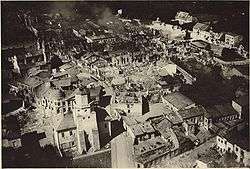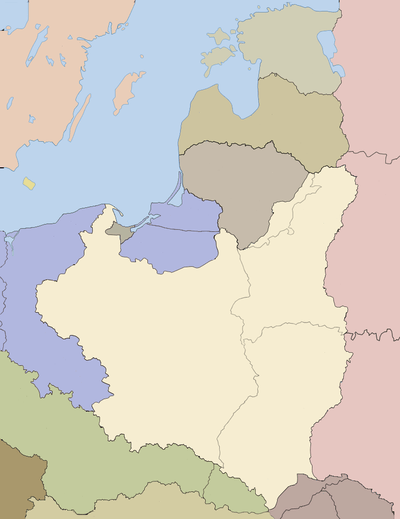Bombing of Wieluń
(map of Poland before the 1939 invasion)
The bombing of Wieluń refers to air raids on the Polish town of Wieluń by the German Luftwaffe on 1 September 1939. The Luftwaffe started bombing Wieluń at 04:40, five minutes before the shelling of Westerplatte, which has traditionally been considered the beginning of World War II. The air raid on the town was one of the first aerial bombings of the war.[1] It killed an estimated 1,300 civilians, injured hundreds more and destroyed 90 per cent of the town centre. There were no military targets of any importance in the area.[2] The casualty rate was more than twice as high as Guernica.[1]
Events
According to German military records, 29 Junkers Ju 87B “Stukas” of Sturzkampfgeschwader 76 under the command of Captain Walter Sigel,[3] started from Nieder-Ellguth airfield at 05:02 on 1 September 1939.[4] Some twenty minutes later they reached the town of Wieluń unopposed and dropped 29 bombs of 500 kg and 112 bombs of 50 kg.[4] Among the first places hit was the hospital, though it had Red Cross markings;[5] 26 patients and 6 nurses were killed.[6] The attack on the hospital was investigated by German prosecutors in 1978 and 1983, but the charges were dropped, since prosecutors felt that the pilots could not make out the nature of the target due to poor lighting conditions at dawn.[4] Within the hour all 29 aircraft landed at Nieder-Ellguth, where Sigel reported "no noteworthy observation of the enemy."[4]
A second wave of 29 Stukas of Sturzkampfgeschwader 2 Immelmann commanded by Major Oskar Dinort attacked the town shortly afterwards,[4] followed by a third wave at about 14:00. In all, 380 bombs totalling 46,000 kg had been dropped on the town, hitting the hospital, killing more than 1,200 inhabitants and destroying 70 per cent of the buildings, up to 90 per cent in the center.[4] According to German documents the town was burning at 06:00 – "Wielun brennt" - Wieluń is burning.[6]
Writer Sylwia Słomińska and Sender Freies Berlin director Joachim Trenkner (author of German 1989 TV documentary about the bombing of Wieluń) stated in the documentary that there were no military or industrial targets in the area,[6][7] except for a small sugar factory in the outskirts of the town. Furthermore, Trenkner stated that German bombers destroyed the town's hospital first.[7]
German historian Horst Boog (de) claims that a Polish cavalry brigade and a Polish infantry division had been located in the town by German reconnaissance the day before the attack. From reports of Luftflotte 4, 2nd Air Division, I./Sturzkampfgeschwader 76 and I./Sturzkampfgeschwader 77 he concludes that the bomb attacks had been directed against these military formations and therefore can not be considered terror bombings. Due to ground fog, he argues, the German pilots missed their targets and mistakenly bombed the town.[8] British aviation historian Peter C. Smith[9] too, describes the bombing as collateral damage from bombs that missed their targets during ground support of the Wehrmacht operations.[9] Polish historian Jerzy B. Cynk, author of The Polish Air Force at War. The Official History 1939-1943, is believed to have also written about these events.[10]
At 13:00 a German dive bomber wing, I./StG 2 led by Major Oskar Dinort via Nieder-Ellguth, were directed against this unit, followed a few hours later by Günter Schwartzkopff with sixty Ju 87 Stukas of I./Sturzkampfgeschwader 77[9] Weather conditions were unfavourable during the day, with a visibility of only one kilometre and a practically closed layer of fog at 50 metres altitude.[11] Fog, mist and poor visibility thwarted many of the Luftwaffe's sorties planned for the morning of the first day of the invasion.[11] The dive bombers, facing intense anti aircraft fire, inflicted heavy losses on the Polish cavalry, and the advance was turned into a rout by 90 Stukas.[9] On their return home, four of the German Junkers Ju 87 bombers were shot down by the Polish 36 Academic Legion Infantry Regiment stationed nearby.[9] Three waves of attacks were carried out during the day.[9] The town was captured by the German Army on the first day of the invasion.[9]
See also
Notes
- 1 2 Davies, Norman (29 August 2009). "We must not forget the real causes of the war". The Independent. Retrieved 2010-02-25.
- ↑ "Nomination Letter for Nobel Peace Prize for Wieluń". Portal Gminy Wieluń. Archived from the original on 2012-04-15.
- ↑ Lexikon der Wehrmacht, Sturzkampfgeschwader 76
- 1 2 3 4 5 6 Trenkner, Joachim (1 September 2009). "Ziel vernichtet" [Target destroyed]. Die Zeit (in German). Hamburg. 2003 (7). Retrieved 4 June 2010.
- ↑ Trenkner, p. 3
- 1 2 3 Słomińska, Sylwia. "Wieluń, 1 września 1939 r" (in Polish). Archived from the original on 2009-01-05.
- 1 2 Trenkner, Joachim (2008-08-29). "Wieluń, czwarta czterdzieści" [Wieluń, four forty am] (PDF) (in Polish). Archived from the original (PDF file, direct download 67.9 KB) on 2012-03-17.
- ↑ Boog, p. 136
- 1 2 3 4 5 6 7 Smith, 2007. p. 23
- ↑ Cynk, p. 74.
- 1 2 Smith, 2007. p. 20
References
- Boog, Horst (1 October 2002). "50. Bombardierung der polnischen Grenzstadt Wielun am 1.9.1939" [Case 50: Bombing of Polish border town Wielun on 1 September 1939]. In Franz Wilhelm Seidler; Alfred M. De Zayas. Kriegsverbrechen in Europa und im Nahen Osten im 20. Jahrhundert [War Crimes in Europe and the Middle East in the 20th Century] (in German). Hamburg, Berlin, Bonn: E.S. Mittler. p. 136. ISBN 3-8132-0702-1.
- Cynk, Jerzy (1998). The Polish Air Force at War. Atglen: Schiffer Pub. ISBN 978-0-7643-0559-7.
Search word - Wielun - did not match any documents.
- Smith, C. Peter. (2007). Ju 87 Stuka Volume One: Luftwaffe Ju 87 Dive-bomber Units 1939-1941. Classic Publications. ISBN 978-1-903223-69-7
Further reading
- Bekker, Cajus. (1994). The Luftwaffe War Diaries. pp. 31–3. OCLC 30353222 ISBN 978-0-306-80604-9
- Bojarska B., Zniszczenie miasta Wielunia w dniu 1 września 1939 r., „Przegląd Zachodni” 1962, nr 2.
- Kulesza W., Pierwszy był Wieluń, „Rzeczpospolita” 1999, nr 211, 9 IX 1999.
- Olejnik T., Wieluń – na pięć minut przed Westerplatte. Pierwsi zginęli cywile, „Tygodnik Powszechny” nr 35, 31 VIII 2003 r.
- Olejnik T., Wieluń. Zniszczenie miasta 1 IX 1939 r., Kępno 1979.
- Olejnik T., Wieluń – polska Guernica, das polnische Guernica, Wieluń 2004.
- Pięciak W., Wieluń 1 września 1939 r., „Tygodnik Powszechny” nr 2, 12 I 2003.
External links
| Wikimedia Commons has media related to Bombing of Wieluń. |
- (Polish) Sylwia Słomińska, September the 1st,(mirror1, mirror2)
- (German) Summary of a German TV report making the case for the bombing of Wielun as a war crime
- Agence France-Presse article on the bombing, entitled "World War II: Where did combat start?", of August 18, 2009, by Jonathan Fowler
- Polish-German documentary “Hitler’s Assault – How World War Two Began”

